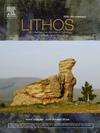Partial melting of hydrated harzburgite at shallow pressures: An option to produce melts with boninitic characteristics
IF 2.9
2区 地球科学
Q2 GEOCHEMISTRY & GEOPHYSICS
引用次数: 0
Abstract
Water-saturated partial melting experiments were carried out using a refractory harzburgite from the Oman Ophiolite as starting material. The experiments were performed at pressures of 100, 200 and 500 MPa using both reducing (corresponding to the FMQ buffer) and oxidizing (FMQ + 3) conditions. Specially designed internally heated pressure vessels were used to control oxygen fugacity and allow rapid quenching. Temperatures varied between 980 and 1220 °C, and run durations were up to 82 h. The solidus and clinopyroxene-out curve show significant variation with pressure. As expected, the melts produced were generally SiO2-rich, with SiO2 concentrations ranging between 55 and 65 wt%. These melts exhibit boninitic characteristics. Due to the refractory character of the starting material, the experimental melts are highly depleted in incompatible trace elements, showing chondrite-normalized REE patterns with a characteristic concave-upward shape. Calcium and sodium in the system are mainly derived from the clinopyroxene in the starting harzburgite, resulting in extremely high Ca/Na ratios in the experimental melts. Fractionation of such melts could potentially yield highly depleted gabbronorites as cumulate rocks, with anorthite (An) contents of plagioclase generally in excess of 90 mol%. At temperatures above the clinopyroxene breakdown, the residual mineral paragenesis exhibits characteristics similar to extremely refractory harzburgites, with Cr# in Cr-spinel (Cr2O3 /(Al2O3 + Cr2O3), molar) reaching up to 86, reminiscent of ophiolites formed under supra-subduction zone conditions.
While most of the melts produced have compositions of high-Mg andesite, only a few have compositions of true boninites. It is clear, therefore, that the partial melting of hydrous harzburgite at shallow pressure is not a general model for the formation of typical boninites in subduction zone initiation environments. However, our experimental results show that the formation of distinct rock types within the paleocrust of the Oman Ophiolite such as high-Ca boninites, high-Si boninites, high-Mg andesites, depleted gabbronorite cumulate rocks, and extremely refractory harzburgites containing Cr-spinel with Cr# > 80, could, in principle, be attributed to a single process of fluid-induced partial melting of harzburgite below the crust/mantle boundary of the Oman paleocrust. The temperatures for the heating process (> 1040 °C) for such a model, could be provided by ascending MORB magmas. The presence of water-rich fluids at the crust/mantle boundary or within the uppermost mantle which are necessary for such a model, could be derived from seawater via deep hydrothermal fault zones. In support of this contention, we present new amphibole data from cores drilled in the lower gabbros of the Oman Ophiolite by the International Continental Scientific Drilling Program (ICDP; Oman Drilling Program), which provide evidence that temperatures of deep hydrothermal fault zones are high enough to trigger the melting of hydrated harzburgites.
浅层压力下水合辉锌矿的部分熔融:一种生产具有碳酸盐特征的熔体的选择
以阿曼蛇绿岩中的一种难熔铝锌矿为原料,进行了水饱和部分熔融实验。实验在100、200和500 MPa的压力下进行,使用还原(对应于FMQ缓冲液)和氧化(FMQ + 3)条件。特别设计的内部加热压力容器用于控制氧气逸度并允许快速淬火。温度在980 ~ 1220℃之间变化,运行时间长达82 h。固相和斜斜磷灰石流出曲线随压力变化显著。正如预期的那样,所产生的熔体通常是富含SiO2的,SiO2浓度在55%到65%之间。这些熔体表现出碳酸盐特征。由于起始材料的难熔性,实验熔体中不相容的微量元素被高度耗尽,呈现出球粒陨石归一化的稀土元素模式,其特征为凹凸向上的形状。体系中的钙和钠主要来源于起始辉石中的斜辉石,导致实验熔体中Ca/Na比值极高。这种熔体的分馏可能产生高度贫辉长岩作为堆积岩,斜长石中的钙长石(An)含量通常超过90摩尔%。在斜辉石击穿温度以上,残余矿物共生表现出与极难熔的尖晶石相似的特征,Cr-尖晶石(Cr2O3 /(Al2O3 + Cr2O3),摩尔)中的Cr#达到86,使人联想到在超俯冲带条件下形成的蛇绿岩。虽然大多数熔体含有高镁安山岩成分,但只有少数含有真正的博宁质成分。因此,浅层压力下含水辉锌矿的部分熔融并不是俯冲带起爆环境下典型辉锌矿形成的一般模式。然而,我们的实验结果表明,在阿曼蛇绿岩的古结壳中形成了不同的岩石类型,如高钙博英岩、高硅博英岩、高镁安山岩、贫辉长岩堆积岩和含Cr尖晶石的极难成岩;80 .原则上,可归因于阿曼古地壳地壳/地幔边界以下由流体引起的部分熔融的单一过程。加热过程的温度(>;1040°C),可以由上升的MORB岩浆提供。在地壳/地幔边界或最上层地幔内存在的富水流体是这种模型所必需的,它们可以通过深海热液断裂带从海水中获得。为了支持这一观点,我们提出了新的角闪孔数据,这些数据来自国际大陆科学钻探计划(ICDP;(阿曼钻探计划)提供的证据表明,深海热液断裂带的温度高到足以引发水合哈尔茨伯尔土的融化。
本文章由计算机程序翻译,如有差异,请以英文原文为准。
求助全文
约1分钟内获得全文
求助全文
来源期刊

Lithos
地学-地球化学与地球物理
CiteScore
6.80
自引率
11.40%
发文量
286
审稿时长
3.5 months
期刊介绍:
Lithos publishes original research papers on the petrology, geochemistry and petrogenesis of igneous and metamorphic rocks. Papers on mineralogy/mineral physics related to petrology and petrogenetic problems are also welcomed.
 求助内容:
求助内容: 应助结果提醒方式:
应助结果提醒方式:


